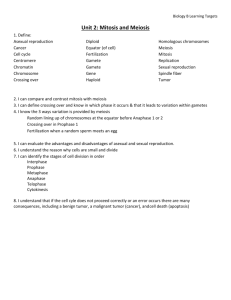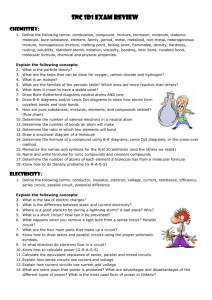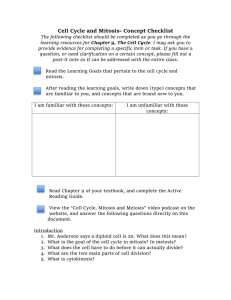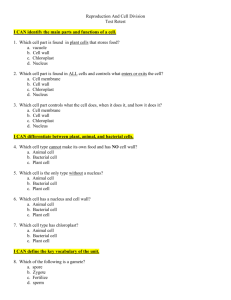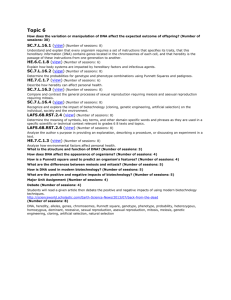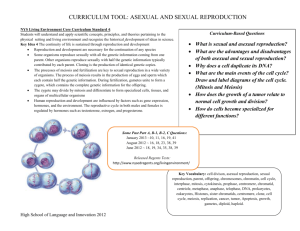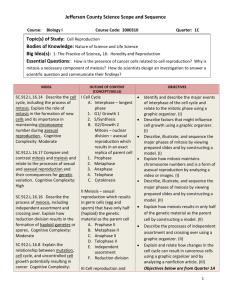Science 9 Final Exam Study Guide
advertisement
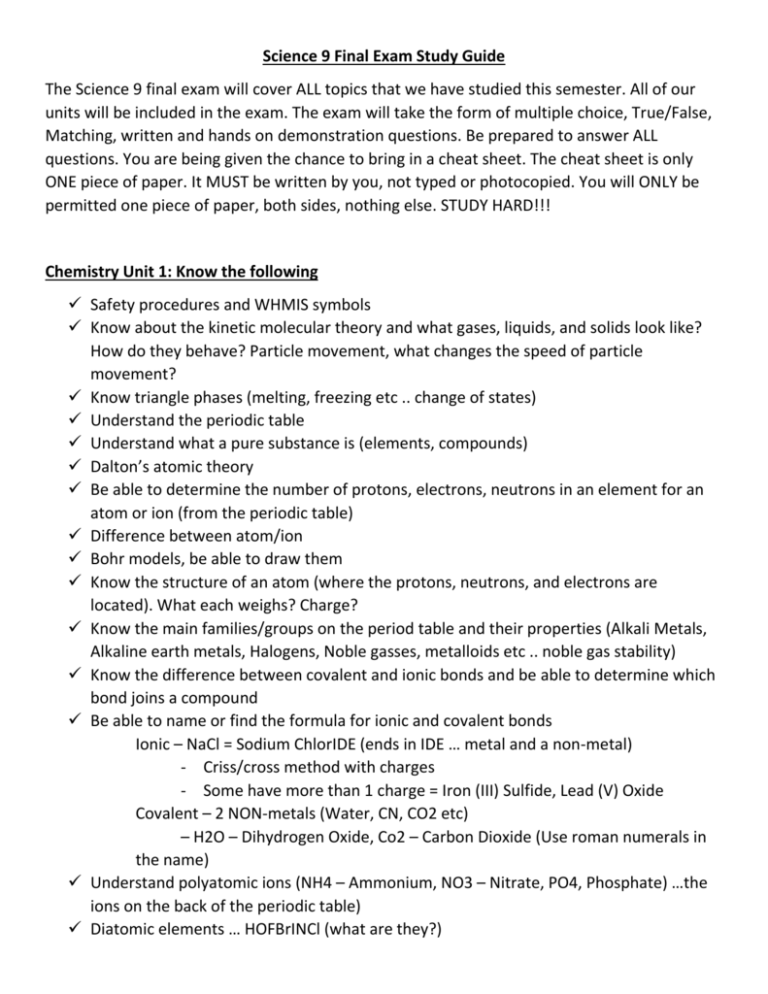
Science 9 Final Exam Study Guide The Science 9 final exam will cover ALL topics that we have studied this semester. All of our units will be included in the exam. The exam will take the form of multiple choice, True/False, Matching, written and hands on demonstration questions. Be prepared to answer ALL questions. You are being given the chance to bring in a cheat sheet. The cheat sheet is only ONE piece of paper. It MUST be written by you, not typed or photocopied. You will ONLY be permitted one piece of paper, both sides, nothing else. STUDY HARD!!! Chemistry Unit 1: Know the following Safety procedures and WHMIS symbols Know about the kinetic molecular theory and what gases, liquids, and solids look like? How do they behave? Particle movement, what changes the speed of particle movement? Know triangle phases (melting, freezing etc .. change of states) Understand the periodic table Understand what a pure substance is (elements, compounds) Dalton’s atomic theory Be able to determine the number of protons, electrons, neutrons in an element for an atom or ion (from the periodic table) Difference between atom/ion Bohr models, be able to draw them Know the structure of an atom (where the protons, neutrons, and electrons are located). What each weighs? Charge? Know the main families/groups on the period table and their properties (Alkali Metals, Alkaline earth metals, Halogens, Noble gasses, metalloids etc .. noble gas stability) Know the difference between covalent and ionic bonds and be able to determine which bond joins a compound Be able to name or find the formula for ionic and covalent bonds Ionic – NaCl = Sodium ChlorIDE (ends in IDE … metal and a non-metal) - Criss/cross method with charges - Some have more than 1 charge = Iron (III) Sulfide, Lead (V) Oxide Covalent – 2 NON-metals (Water, CN, CO2 etc) – H2O – Dihydrogen Oxide, Co2 – Carbon Dioxide (Use roman numerals in the name) Understand polyatomic ions (NH4 – Ammonium, NO3 – Nitrate, PO4, Phosphate) …the ions on the back of the periodic table) Diatomic elements … HOFBrINCl (what are they?) Know the difference between physical/chemical changes (give examples) Know what exothermic/endothermic reactions are Balancing equations If you can do the UNITE review on Pg 112, you will be just FINE Biology, Unit 2 Know the parts and functions of plant and animal cells Know the importance of the nucleus Understand what DNA is, the structure in detail Nitrogen bases and how they connect (A, T, C, G) Understand what mutations (and mutagens) are, know examples and determine a mutation in the genetic code (deletion, addition, substitution, positive, negative, neutral etc) Gene therapy Understand the cell cycle – diagrams What stops cells from dividing? Know the stages of mitosis (in order) as well as what mitosis produces (looking at pictures) Know stages of meiosis (in order) and what meiosis produces Know the difference between mitosis/meiosis Know the advantages and disadvantages of asexual and sexual reproduction Know forms of asexual reproduction (binary fission, budding, fragmentation etc) Know different methods of assisted reproduction (artificial insemination) Know what chromosomes, genes, DNA are and how they relate to each other Internal vs external fertilization Embryonic/fetal development – trimesters (what is happening) What is cancer? If you are able to do the UNIT review on Pg 238 you will be just FINE Physics, UNIT 3 Know the static charge laws (what is static electricity? Opposites attract) Know what conductors and inductors/insulators are and be able to give examples Determine from diagrams/pics/descriptions how objects will react (attract/repel) and the charges on different items (the sock and the silk skirt) Electric force, what is it? Ohms law – what is it, how do you calculate resistance? Know what power, resistance, current, and voltage are and be able to do calculations to determine their values Know ALL FORMULAS for electricity Know the difference between parallel/series circuits Be able to construct parallel/series circuits (working circuits) Draw diagrams of circuits using proper symbols Diagram of a battery – label it Be able to use equations to solve Watt, Voltage, Current, Energy (joules and KW*h) If you can do the questions in the electricity booklet you will be just FINE Space, Unit 4 Understand the Big Bang Theory Know the different types of galaxies (spiral, elliptical, irregular) Which galaxy are we a part of? Birth of a star Doppler effect Our planets This is a study GUIDE. There is more information that you will need to get from your notes and activities that we have done in class this semester. Make sure you understand and know the information. Review all notes. EXAM (Tuesday) January 26th @ 8:30 SHARP! Do not be late and DO NOT MISS IT!!! Any noshows will be a ZERO – NO EXCEPTIONS! Study hard, use your cheat sheet and you will be JUST FINE!!!!
